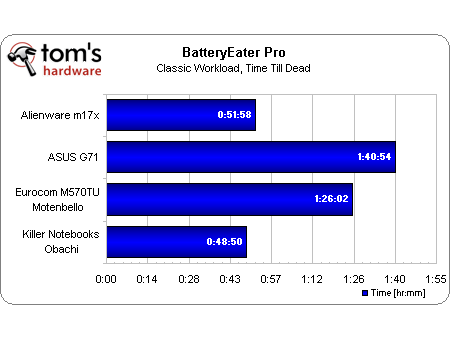SLI & Centrino 2: Gaming Laptops Battle
Benchmark Results: Battery Life
Running a desktop replacement or gaming notebook on battery power is almost an exercise in futility. Simply powering some of these systems on eats up six or seven percent of the battery. We set all four systems to their Balanced power plans and specified that the display/hard drive were to never switch off.
We ran all four machines through two rounds of BatteryEater Pro, an excellent alternative to MobileMark 2007’s battery test (one product in a family of horribly buggy benchmarks). There are a handful of different workloads you can apply through BatteryEater, but we used the classic test running an OpenGL-rendered window until depletion. In other words, these aren’t the run times you’d expect when gaming on these machines. Rather, it’s a medium workload that should reflect constant use (another workload included with BatteryEater measures battery life at continuous idle).
Not surprisingly, the notebook you’d be least likely to use away from an outlet is Killer Notebooks’ Odachi. Maybe even more shocking though, is that Alienware’s m17x only lasts about three minutes more, despite its Core 2 Extreme processor and mobility-optimized chipset.
The two Centrino 2 notebooks steal the show when it comes to longevity. Eurocom’s Montebello is able to almost double the run time of the Odachi—never mind that it’s sporting a Core 2 Extreme X9100 running at more than 3 GHz. ASUS adds an extra 15 minutes on top of that, even though the G71 wields two hard drives.
We made it a point to emphasize performance over all else in requesting these machines. But it’s certainly good to know that even as Eurocom and ASUS trail in the benchmarks, they are able to redeem themselves in measures of efficiency. With that said, anyone who wants to play the latest gaming titles without a power outlet handy is still looking at a short-lived experience, regardless of the platform one uses.
Get Tom's Hardware's best news and in-depth reviews, straight to your inbox.
Current page: Benchmark Results: Battery Life
Prev Page Benchmark Results: Synthetics Next Page Pricing And Conclusion-
kitsilencer From a money point of view, it's never going to make sense buying a gaming laptop. Scaled down performance and inability to upgrade are issues.Reply
But it sure as hell feels good having one ^___^ -
neiroatopelcc http://www.tomshardware.com/reviews/gaming-notebook-roundup,2023-6.htmlReply
"shipped the system with a 64-bit copy of Vista Ultimate (Alienware included x32 Home Premium)." -
ap90033 4 Grand? Are you guys nuts? I would say that right there would rule out about 90% of us normal gmaers..Reply
Besides the gaming scores looked weak imo..
I personally thought it was a better idea to go get a Gateway P7811FX with a single Geforce 9800GTS. It plays Call of Duty at 1920x1200 max settings around 50FPS. AND it cost me ONLY $1249 (Plus Best Buy let me pick any game I wanted for FREE!) -
agree with kitsilencer, gaming laptop is never practical.Reply
even with a beast graphics card, you'd be pretty hard to get more than 2 hours of shitty performance.
get a gaming desktop and perhaps an EEE or iPhone for travelling. my iPhone has 20+ games and enough media (don't forget TV connector for watching films in hotels) to keep me busy for more than one week away from my gaming rig. -
ap90033 Not true my "Gmaing Laptop" is great at LAN Parties and I play it for 6-8 Hours straight there...Reply
I think maybe you had a bad experience with a laptop that claimed to be a "gaming" laptop. I bought one before like that and it have an 8600M Geforce and it Sucked bad... If you get a good laptop with say a 9800gts or so you would be suprised... -
GlItCh017 ap900334 Grand? Are you guys nuts? I would say that right there would rule out about 90% of us normal gmaers..99.90%Reply -
ap90033 PS gaming laptops hold value much better than desktops. I had one I paid 1250 for, had it for a year, then sold it for $1100 and bought the newer "upgraded" model that just came out for $1250. I got an Upgraded CPU (From Core 2 1.67 GHZ to Core 2 Centrino 2 2.26 GHZ), Memory (from 3 Gigs DDR2 667MHZ to 4 Gigs DDR3 1066MHZ), Hard Drive (faster), Video Card (from 8800gts to 9800GTS), Screen (from 1440x800 to 1920x1200) and OS (From 32 bit to 64 bit). Not bad upgrade for $150 or so!Reply

